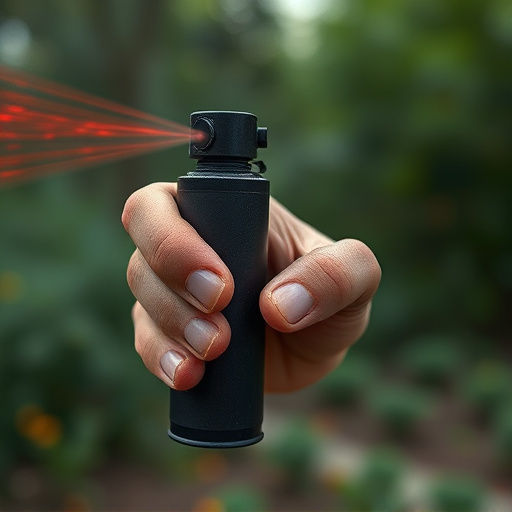Storing pepper spray equipment properly is crucial for maintaining its effectiveness (up to 90% potency) and readiness in high-risk law enforcement situations. Agencies should store both oleoresin capsicum (OC) spray and aerosol sprays in cool, dry, secure environments, with proper labeling and regular inventory checks. Training officers on handling, application techniques, and expiration dates is essential. Compliance with regional regulations ensures optimal performance, officer safety, and legal standards.
“Law enforcement agencies rely on pepper spray as a crucial non-lethal force tool. This comprehensive guide delves into the essential aspects of pepper spray equipment, from understanding its types and components to best practices for storing and handling. We explore safe use training, legal considerations, and regulations, emphasizing the significance of proper storage for maximum effectiveness. By adhering to these practices, law enforcement can ensure their pepper spray remains a reliable asset in public safety.”
- Understanding Pepper Spray Equipment: Types and Components
- Best Practices for Storing Pepper Spray to Maintain Efficiency
- Ensuring Safe Handling and Use: Training and Safety Measures
- Legal Considerations and Regulations for Law Enforcement Pepper Spray
Understanding Pepper Spray Equipment: Types and Components
Pepper spray equipment is a critical component of law enforcement arsenal, designed to incapacitate and subdue individuals in various high-risk situations. Understanding the different types and components of this equipment is essential for optimal deployment and effectiveness. Modern pepper spray comes in two primary forms: oleoresin capsicum (OC) spray and aerosol spray. OC spray, derived from chili peppers, causes intense irritation and temporary blindness, making it a popular choice for law enforcement due to its high potency and quick effect. Aerosol sprays, on the other hand, use a pressurized can to deliver a mist of capsaicin, the active ingredient in chili peppers, offering a slightly less concentrated but broader area of coverage.
Effective storage plays a vital role in maintaining pepper spray equipment for maximum effectiveness. Law enforcement agencies must adhere to specific guidelines when storing these products. Ideal storage conditions include cool, dry, and secure environments, away from direct sunlight or extreme temperatures. Proper labeling and regular inventory checks are also crucial to ensure the integrity of the stock. Additionally, training officers on how to properly maintain and inspect their equipment, including checking for leaks, ensuring proper functionality, and understanding expiration dates, is essential for keeping pepper spray ready for immediate use when needed.
Best Practices for Storing Pepper Spray to Maintain Efficiency
Storing pepper spray properly is essential for maintaining its maximum effectiveness and ensuring law enforcement officers have a reliable tool when needed. The ideal storage conditions for pepper spray include cool, dry, and dark environments. Extreme temperatures, whether hot or cold, can degrade the chemical composition of the spray, reducing its potency over time. Direct sunlight should be avoided as well, as it can cause premature evaporation.
When storing pepper spray equipment, it’s recommended to keep them in secure, labeled containers designed specifically for this purpose. These containers should be sealed tightly to prevent contamination and accidental discharge. Additionally, proper labeling is crucial to easily identify the contents and expiration dates, ensuring officers have quick access to vital information during operations. Regular inventory checks are also advisable to track usage and detect any potential issues with the spray’s integrity.
Ensuring Safe Handling and Use: Training and Safety Measures
Ensuring safe handling and use of pepper spray equipment is paramount to maintaining law enforcement officers’ effectiveness and safety in the field. Proper training and adherence to safety measures are crucial steps in maximizing the spray’s impact while minimizing risks. Officers should be schooled in the correct application techniques, including proper targeting, distance, and follow-up actions. Understanding the spray’s range, duration, and deactivation processes is essential for tactical decision-making.
Safe storage of pepper spray is another critical aspect that contributes to its maximum effectiveness. This includes keeping the equipment in designated, secure containers, away from direct sunlight and extreme temperatures, which can degrade the spray. Storing them properly ensures the integrity of the solution and maintains optimal performance when needed. Regular inventory checks and prompt replacement of expired or damaged supplies are integral parts of responsible pepper spray management.
Legal Considerations and Regulations for Law Enforcement Pepper Spray
Law enforcement pepper spray is a powerful tool, but its use comes with stringent legal considerations and regulations. Agencies must adhere to strict guidelines regarding storage, handling, and deployment to ensure fairness, safety, and accountability. The proper storage of pepper spray equipment is paramount for maintaining maximum effectiveness and compliance. This includes secure, designated areas that meet specific temperature and humidity requirements, as well as clear labeling and regular maintenance to prevent contamination or degradation.
Regulations vary by jurisdiction, but common standards dictate the type of container used, safety protocols for officers, and procedures for documenting and tracking each spray canister. Effective inventory management systems are crucial for monitoring usage and ensuring that pepper spray remains accessible during operational deployments. Additionally, training programs must equip officers with the knowledge to use pepper spray responsibly, minimizing its impact on bystanders and adhering to legal limits as dictated by state or local laws.
Law enforcement pepper spray is a valuable tool when used responsibly and effectively. By understanding the different types, storing it properly to maintain efficiency, implementing safe handling practices, and adhering to legal regulations, officers can maximize its effectiveness in critical situations. Continuous training and staying informed about updated guidelines are essential to ensure public safety and the optimal use of this powerful equipment.
